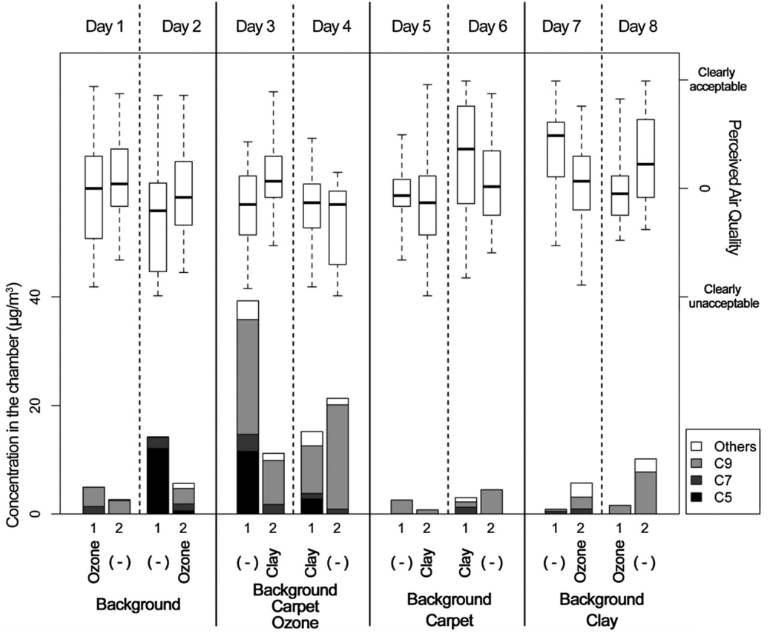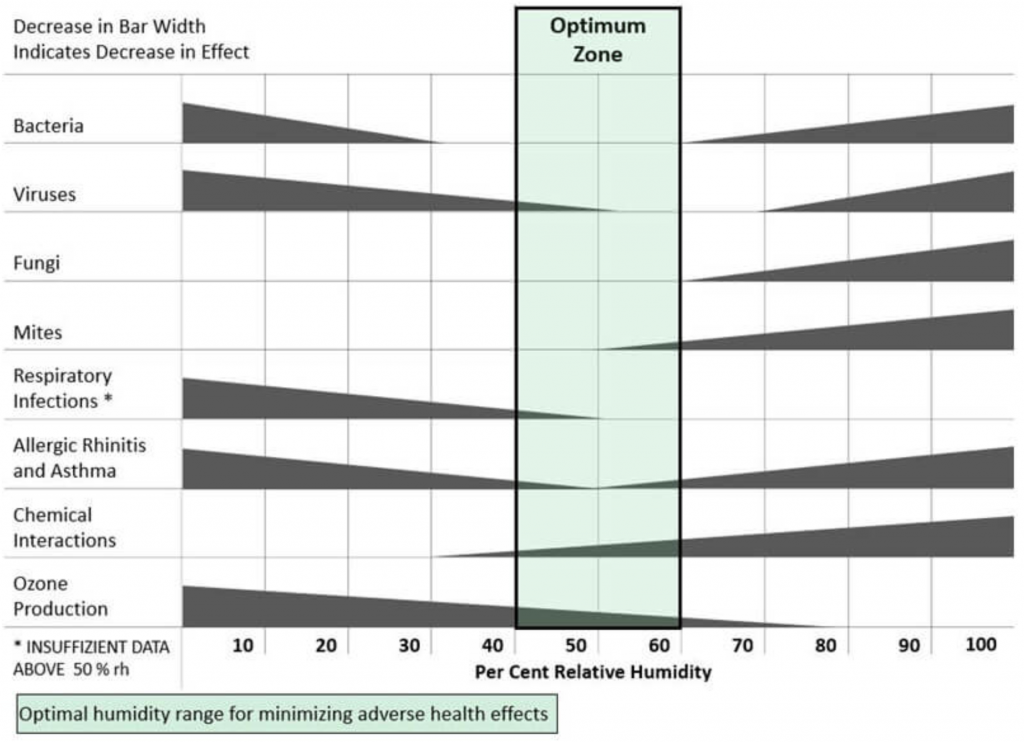Introduction
In an effort to reduce energy consumption in buildings, new construction methods and products are making their way in the building industry. Some of the more common practices to limit energy losses include increasing envelope airtightness and insulation. Airtight buildings, however, are usually associated with reduced ventilation rates. Thus, in this context, the effect of indoor emissions is magnified and more care should be taken in the selection of building materials which are one of the primary sources of indoor emissions.
In parallel, the current climate crisis has led owners and builders to progressively turn to bio-sourced or bio-based materials in construction as a way to minimize the environmental impact and embodied carbon of the building. Some of these eco-friendlier materials include (i) insulations from wood fibre, hemp or sheep wool, (ii) plasters derived from clay or lime and (iii) structural materials such as wood or stabilized earth. It is therefore interesting to evaluate the impact of this growing category of products on indoor air quality.
Insulations
Traditional insulation materials such as mineral stone wool, fiberglass or expanded/extruded polystyrene (EPS/XPS) do not emit particularly high levels of VOCs [1]. In comparison, bio-based insulations perform similarly in terms of VOC emissions. Research on a variety of these insulations has shown that the TVOC emissions while noticeable especially in the first week, were not particularly significant after a month [2]. Therefore, in terms of VOC emissions, there isn’t much difference between mineral or synthetic and bio-sourced insulations.
Typically, bio-based insulation materials are used in breathable assemblies since they allow for moisture diffusion thus preventing condensation of water vapour inside the assembly [2]. This water-permeable characteristic consequently reduces the risk for mould growth which is associated with asthma and allergic reactions. One study compared the dynamic moisture sorption of bio-based insulation to that of EPS insulation, and it was shown that the bio-based insulations could absorb 3-7 times more moisture. Nevertheless, in order to benefit from this moisture sorption capacity and high vapour diffusivity, the assembly breathability must be ensured which depends on its composition (paints, coatings, vapour barriers, plasters…) [3].
Furthermore, some bio-based insulation materials also benefit from their inherent natural properties although the effect of these might be limited due to the fact that insulations are typical not directly exposed to indoor air. Wool insulation, for example, is able to purify indoor air thanks to the presence of amine groups which are highly reactive with VOCs such as formaldehyde [2]. Moreover, hemp-based insulations benefit from the natural hypoallergenic property of the hemp plant itself.

Figure 1. Bio-based insulation samples [7]
Plasters
Bio-based plasters are gaining popularity in construction, particularly in Europe. Such products include lime- and clay-based plasters. These plasters would occupy large indoor surface areas on walls and thus have the potential to impact IAQ more directly and significantly compared to insulation materials since they would be in direct contact with indoor air.
In a similar fashion to the bio-based insulation materials, the eco-friendly plasters all exhibit high breathability through their hygroscopic porous structure, which contributes to the moisture buffering effect. This means that the material can absorb moisture when indoor relative humidity is high, and release it at a later time when indoor relative humidity is lower. This effect helps to limit exposures to high indoor moisture content, and also affects indoor ventilation control in that the ventilation rates required for moisture removal can be reduced [4].
Clay plasters have been studied for their impact on IAQ by assessing the perceived air quality (PAQ) in different indoor conditions (with/without ozone, carpet, clay plaster). As illustrated in Figure 2, in cases where the clay plaster was present, the PAQ was generally higher than when it wasn’t present. Some reasons behind this difference in PAQ relate to the reactivity of clay plasters and its adsorption. Indeed, ozone concentrations were lower in the presence of the clay plaster and aldehyde byproducts from the reactivity with ozone in the rooms was lower as well [5]. Another study on the ozone reactivity of several green materials, showed that clay wall plaster was the only material from those tested to achieve both very high deposition velocities (ozone removal) and very low carbonyl byproduct formation [6].

Figure 2.Perceived air quality and related aldehyde concentrations in test chambers to assess the influence of clay plaster [5]
Lime-based plasters are also effective in VOC adsorption. One study examined the sorption properties of a lime-cellulose mix and it was seen that it was particularly effective at adsorbing certain VOCs such as formaldehyde and dodecane [7] thus increasing IAQ.
Construction materials – Wood and Earth
Regarding wood-based construction materials, although there is significant variation between different products, it has been shown that they are some of the main contributors to indoor emission of certain VOCs such as aldehydes and terpenes. This is mainly due to the binding resins containing formaldehyde in plywood or MDF for example [8] but also partly due to the organic nature of wood. In this sense, wood-based construction materials can be seen as having negative effects on IAQ. However, VOC emissions from wood-based products are mainly problematic immediately after construction or renovation, and the steady state emissions are below most thresholds. As shown in the case of wood remodelled welfare facilities, the IAQ was deemed improved following the renovation and satisfied the international guidelines. In addition, these wood remodelling were effective in lowering the particulate matter and formaldehyde concentrations in the facilities [10].
Furthermore, some of the VOCs emitted from wood products were actually shown to present some human health benefits according to recent studies. For example, compounds such as α-pinene and d-limonene play a role in physiological relaxation and lower blood pressure, while monoterpenes were found to have antimicrobial, anti-inflammatory antipruritic, analgesic and stress reducing properties [9].
Stabilized earth structures, on the other hand, are made from soil “only in its mineral phase excluding the organic phase usually present in the first layers” [11]. Moreover, the stabilization process is based on moisture removal and pressure, not relying on any chemical binding agent. Thus, contrary to other organic bio-based construction materials, stabilized earth structure will not emit any VOCs, helping improve IAQ.

Figure 3. Weight of moisture absorbed by different materials when relative humidity increases from 50% to 80% [11]
Additionally, wood and earth are also hygroscopic materials and act effectively to moderate indoor moisture, and temperature contributing to better indoor air quality. Multiple studies have reported the benefits of these materials in this regard. The impacts of the moisture buffering capacity of these materials increases with the surface area coverage of the materials, and thus keeping these materials exposed on the interior can have a significant influence on indoor air conditions. One research by Simonson et al. has shown that humidity regulation from hygroscopic wood structures can improve the PAQ, demonstrated by a reduction of up to 25% of percent people dissatisfied compared to an impermeable structure. Another study on stabilized earth structures, demonstrated the capability of this material to maintain indoor humidity levels between 40 and 60%, which is the ideal range for human health purposes [11].

Figure 4. Optimum relative humidity range for minimizing adverse health effects – Adapted from [14]
Conclusion
As outlined by W. Nazaroff, the four key principles for achieving good indoor air quality are: reducing the indoor emissions, controlling humidity and moisture, protecting against outdoor sources and ventilating well. Of these principles, bio-based materials were seen to positively impact the first three to some extent.
The most prevalent mechanism for improving IAQ consists of the moisture buffering capacity of these materials due to their hygroscopic nature which helps avoid moisture-related respiratory illnesses. Furthermore, VOC emissions of these eco-friendly materials were seen to be either comparable or lower than conventional building materials and, in the case of wood products, even potentially beneficial to human health. Lastly, the porous nature, filtering capability and high adsorption properties of some the materials contributes to limiting ingress of outdoor pollutants and their reactivity with indoor pollutants.
Bibliography
| [1] |
G. N. W. Y. a. P. C. Doyun Won, “Material Emissions Testing: VOCs from Wood, Paint, and Insulation Materials,” National Research Council Canada, 2014. |
| [2] |
D. d. S. C. F. M. K. R. C. D. A. B. R. J. A. M. P. T. A. P. U. &. W. P. J. Maskell, “Bio-based plaster for improved indoor air quality,” Academic Journal of Civil Engineering, vol. 35, no. 2, pp. 637-642, 2017. |
| [3] |
A. L. M. G. L. H. E. C. M. Palumbo, “Bio-based insulation materials and their hygrothermal performance in a building envelope system (ETICS),” Energy & Buildings, vol. 174, pp. 147-155, 2018. |
| [4] |
D. M. A. S. P. W. Valeria Cascione, “Full-Scale Simulation of Indoor Humidity and Moisture Buffering Properties of Clay,” in Earthen Dwellings and Structures, Springer Transactions in Civil and Environmental Engineering, 2019, pp. 395-406. |
| [5] |
C. J. C. P. W. J. K. G. C. M. R. L. C. Erin K. Darling, “Impacts of a clay plaster on indoor air quality assessed using chemical and sensory measurements,” Building and Environment, vol. 233, pp. 370-376, 2012. |
| [6] |
R. C. G. M. S.P. Lamble, “Ozone deposition velocities, reaction probabilities and product yields for green building materials,” Atmospheric Environment, vol. 45, pp. 6965-6972, 2011. |
| [7] |
C. F. d. S. K. M. C. R. A. D. R. J. B. M. P. A. P. J. W. A. S. D.Maskell, “Properties of bio-based insulation materials and their potential impact on indoor air quality,” in International Conference on Bio-Based Materials, Bath, 2015. |
| [8] |
N. L. F. T. P. Harb, “Emissions and treatment of VOCs emitted from wood-based construction materials: Impact on indoor air quality,” Chemical Engineering Journal, vol. 354, pp. 641-652, 2018. |
| [9] |
B.-A. L.-J. P. J.-C. K. Youn-Suk Son, “Characteristics of volatile organic compounds (VOCs) emitted from building materials to improve indoor air quality: focused on natural VOCs,” Air Qual Atmos Health, pp. 737-746, 2013. |
| [10] |
J. L. S. W. S. K. Hyun Mi Cho, “Field study on indoor air quality of wood remodeled welfare facilities for physical and psychological benefits,” Journal of Cleaner Production, pp. 197-208, 2019. |
| [11] |
S. J. F. Pacheco-Torgal, “Earth construction: Lessons from the past for future eco-efficient construction,” Construction and Building Materials, vol. 29, pp. 512-519, 2012. |
| [12] |
M. S. T. O. C. J. Simonson, “The effect of structures on indoor humidity – possibility to improve comfort and perceived air quality,” Indoor Air, vol. 12, pp. 243-251, 2002. |
| [13] |
W. W. Nazaroff, “Four principles for achieving good indoor air quality,” Indoor Air, vol. 23, no. 5, pp. 353-356, 2013. |
| [14] |
E. M. S. J. H. B. T. D. S. Anthony V. Arundel, “Indirect Health Effects of Relative Humidity in Indoor Environments,” Environmental Health Perspectives, vol. 65, pp. 351-361, 1986. |

